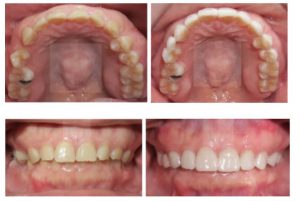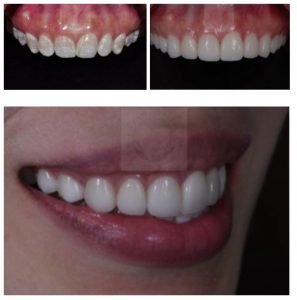A dental veneer is a layer of medical-grade porcelain or resin composite that is placed over the facial surfaces of your teeth for an immediate smile transformation while also providing strength and resilience comparable to natural tooth enamel. It is often the treatment of choice for those looking to make slight tooth position alterations or to change tooth shape, size, and/or color. Individually crafted for each patient.
These cosmetic enhancements are made from advanced material that closely resembles the appearance of natural dental enamel. Thanks to their lifelike appearance and wide array of functions, porcelain veneers rank among the most trusted and popular procedures in cosmetic dentistry.

Patients who are considering porcelain veneers are typically looking to address multiple structural or cosmetic issues with their teeth, such as chips, cracks, gaps between teeth, minor misalignment, or discoloration.
To have porcelain veneers placed, patients should:

Before and After Photos
43-year-old patient with a chief complaint of unsatisfied tooth shape, tooth color, spacing, and an unpleasant smile.
Minimal tooth preparation was done to create space for porcelain veneers.
32 year-old patient with a chief complaint of unsatisfied tooth color and unpleasant smile.

Before and After Photos
Teeth whitening is the process of changing the color of natural teeth using a bleaching agent that reacts with the enamel and natural dentin, resulting in whiter teeth. Veneers are made by placing a material, which may be a composite resin or ceramic, on the surface of natural tooth enamel, which must be ground down to some extent, so they can be called cosmetic artificial teeth.
The decision on whether to get veneers or teeth whitening depends on what you want to improve. If you don’t have a problem with the shape or alignment of your teeth and just want to whiten your natural teeth, you may only need to get teeth whitening. However, if you want to improve the color, shape, length, and alignment of your teeth, veneers can meet this requirement.
However, some types of teeth may not be as white as desired after bleaching, such as teeth with a dark gray color caused by taking antibiotics / teeth that are dark because the tooth is dead. In these cases, veneers are more suitable and provide better aesthetics.